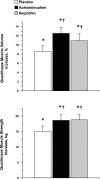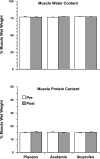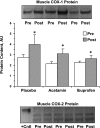Influence of acetaminophen and ibuprofen on skeletal muscle adaptations to resistance exercise in older adults - PubMed (original) (raw)
Randomized Controlled Trial
. 2011 Mar;300(3):R655-62.
doi: 10.1152/ajpregu.00611.2010. Epub 2010 Dec 15.
Affiliations
- PMID: 21160058
- PMCID: PMC3064281
- DOI: 10.1152/ajpregu.00611.2010
Randomized Controlled Trial
Influence of acetaminophen and ibuprofen on skeletal muscle adaptations to resistance exercise in older adults
Todd A Trappe et al. Am J Physiol Regul Integr Comp Physiol. 2011 Mar.
Abstract
Evidence suggests that consumption of over-the-counter cyclooxygenase (COX) inhibitors may interfere with the positive effects that resistance exercise training has on reversing sarcopenia in older adults. This study examined the influence of acetaminophen or ibuprofen consumption on muscle mass and strength during 12 wk of knee extensor progressive resistance exercise training in older adults. Thirty-six individuals were randomly assigned to one of three groups and consumed the COX-inhibiting drugs in double-blind placebo-controlled fashion: placebo (67 ± 2 yr; n = 12), acetaminophen (64 ± 1 yr; n = 11; 4 g/day), and ibuprofen (64 ± 1 yr; n = 13; 1.2 g/day). Compliance with the resistance training program (100%) and drug consumption (via digital video observation, 94%), and resistance training intensity were similar (P > 0.05) for all three groups. Drug consumption unexpectedly increased muscle volume (acetaminophen: 109 ± 14 cm(3), 12.5%; ibuprofen: 84 ± 10 cm(3), 10.9%) and muscle strength (acetaminophen: 19 ± 2 kg; ibuprofen: 19 ± 2 kg) to a greater extent (P < 0.05) than placebo (muscle volume: 69 ± 12 cm(3), 8.6%; muscle strength: 15 ± 2 kg), when controlling for initial muscle size and strength. Follow-up analysis of muscle biopsies taken from the vastus lateralis before and after training showed muscle protein content, muscle water content, and myosin heavy chain distribution were not influenced (P > 0.05) by drug consumption. Similarly, muscle content of the two known enzymes potentially targeted by the drugs, COX-1 and -2, was not influenced (P > 0.05) by drug consumption, although resistance training did result in a drug-independent increase in COX-1 (32 ± 8%; P < 0.05). Drug consumption did not influence the size of the nonresistance-trained hamstring muscles (P > 0.05). Over-the-counter doses of acetaminophen or ibuprofen, when consumed in combination with resistance training, do not inhibit and appear to enhance muscle hypertrophy and strength gains in older adults. The present findings coupled with previous short-term exercise studies provide convincing evidence that the COX pathway(s) are involved in the regulation of muscle protein turnover and muscle mass in humans.
Figures
Fig. 1.
Change in quadriceps muscle volume and muscle strength from the beginning to the end of the 12-wk resistance exercise training and drug intervention. *Significant increase from pretraining across all three groups, P < 0.05; †ANCOVA revealed a significant increase compared with placebo, P < 0.05.
Fig. 2.
Skeletal muscle (vastus lateralis) water content and protein content at the beginning and the end of the 12-wk resistance exercise training and drug intervention. There was no influence of drug consumption or resistance training on either parameter. Acetamin, acetaminophen.
Fig. 3.
Skeletal muscle (vastus lateralis) cyclooxygenase (COX)-1 and COX-2 protein content at the beginning and the end of the 12-wk resistance exercise training and drug intervention. *Significant increase from pretraining across all 3 groups, P < 0.05. There was no influence of drug consumption on COX-1 protein. The image for the COX-1 protein reflects a representative Western blot showing an increase from pre- to posttraining in each of the 3 groups. The image for the COX-2 protein reflects a representative Western blot showing a lack of detectable COX-2 protein migrating with the human recombinant COX-2 positive control protein pre- or posttraining in any of the 3 groups. See
materials and methods
and Burd et al. (5) for further description of the analytical considerations and the two lower migrating bands, which also did not change over the 12 wk, AU, arbitrary units.
Similar articles
- COX Inhibitor Influence on Skeletal Muscle Fiber Size and Metabolic Adaptations to Resistance Exercise in Older Adults.
Trappe TA, Ratchford SM, Brower BE, Liu SZ, Lavin KM, Carroll CC, Jemiolo B, Trappe SW. Trappe TA, et al. J Gerontol A Biol Sci Med Sci. 2016 Oct;71(10):1289-94. doi: 10.1093/gerona/glv231. Epub 2016 Jan 26. J Gerontol A Biol Sci Med Sci. 2016. PMID: 26817469 Free PMC article. Clinical Trial. - Influence of acetaminophen and ibuprofen on in vivo patellar tendon adaptations to knee extensor resistance exercise in older adults.
Carroll CC, Dickinson JM, LeMoine JK, Haus JM, Weinheimer EM, Hollon CJ, Aagaard P, Magnusson SP, Trappe TA. Carroll CC, et al. J Appl Physiol (1985). 2011 Aug;111(2):508-15. doi: 10.1152/japplphysiol.01348.2010. Epub 2011 May 19. J Appl Physiol (1985). 2011. PMID: 21596925 Free PMC article. Clinical Trial. - Prior acetaminophen consumption impacts the early adaptive cellular response of human skeletal muscle to resistance exercise.
D'Lugos AC, Patel SH, Ormsby JC, Curtis DP, Fry CS, Carroll CC, Dickinson JM. D'Lugos AC, et al. J Appl Physiol (1985). 2018 Apr 1;124(4):1012-1024. doi: 10.1152/japplphysiol.00922.2017. Epub 2018 Jan 11. J Appl Physiol (1985). 2018. PMID: 29357482 Clinical Trial. - Effects of prostaglandins and COX-inhibiting drugs on skeletal muscle adaptations to exercise.
Trappe TA, Liu SZ. Trappe TA, et al. J Appl Physiol (1985). 2013 Sep;115(6):909-19. doi: 10.1152/japplphysiol.00061.2013. Epub 2013 Mar 28. J Appl Physiol (1985). 2013. PMID: 23539318 Free PMC article. Review. - Analgesic and anti-inflammatory drugs in sports: Implications for exercise performance and training adaptations.
Lundberg TR, Howatson G. Lundberg TR, et al. Scand J Med Sci Sports. 2018 Nov;28(11):2252-2262. doi: 10.1111/sms.13275. Epub 2018 Sep 2. Scand J Med Sci Sports. 2018. PMID: 30102811 Review.
Cited by
- Acute Sarcopenia: Mechanisms and Management.
Damanti S, Senini E, De Lorenzo R, Merolla A, Santoro S, Festorazzi C, Messina M, Vitali G, Sciorati C, Rovere-Querini P. Damanti S, et al. Nutrients. 2024 Oct 10;16(20):3428. doi: 10.3390/nu16203428. Nutrients. 2024. PMID: 39458423 Free PMC article. Review. - Bugs on Drugs: Paracetamol Exposure Reveals Genotype-Specific Generational Effects on Life History Traits in Drosophila melanogaster.
Hundebøl BNRG, Rohde PD, Kristensen TN, Jensen RWM, Vosegaard T, Sørensen JG. Hundebøl BNRG, et al. Insects. 2024 Oct 1;15(10):763. doi: 10.3390/insects15100763. Insects. 2024. PMID: 39452339 Free PMC article. - Emerging Targets and Treatments for Sarcopenia: A Narrative Review.
Cacciatore S, Calvani R, Esposito I, Massaro C, Gava G, Picca A, Tosato M, Marzetti E, Landi F. Cacciatore S, et al. Nutrients. 2024 Sep 27;16(19):3271. doi: 10.3390/nu16193271. Nutrients. 2024. PMID: 39408239 Free PMC article. Review. - Association between persistent musculoskeletal pain and incident sarcopenia in China: the mediating effect of depressive symptoms.
Zhou S, Liu Y, Zhang Y, Luo N, Chen Q, Ge M, Shen B. Zhou S, et al. Front Public Health. 2024 Sep 4;12:1416796. doi: 10.3389/fpubh.2024.1416796. eCollection 2024. Front Public Health. 2024. PMID: 39296844 Free PMC article. - Contractile regulation of the glucocorticoid-sensitive transcriptome in young and aged skeletal muscle.
Laskin GR, Waddell DS, Vied C, Gordon BS. Laskin GR, et al. Am J Physiol Endocrinol Metab. 2024 Nov 1;327(5):E636-E652. doi: 10.1152/ajpendo.00223.2024. Epub 2024 Sep 11. Am J Physiol Endocrinol Metab. 2024. PMID: 39259162
References
- Berg HE, Tedner B, Tesch PA. Changes in lower limb muscle cross-sectional area and tissue fluid volume after transition from standing to supine. Acta Physiol Scand 148: 379–385, 1993 - PubMed
- Bergstrom J. Muscle electrolytes in man. Scand J Clin Lab Invest 14: 7–110, 1962 - PubMed
- Biolo G, Fleming RY, Maggi SP, Wolfe RR. Transmembrane transport and intracellular kinetics of amino acids in human skeletal muscle. Am J Physiol Endocrinol Metab 268: E75–E84, 1995 - PubMed
- Bondesen BA, Mills ST, Pavlath GK. The COX-2 pathway regulates growth of atrophied muscle via multiple mechanisms. Am J Physiol Cell Physiol 290: C1651–C1659, 2006 - PubMed
Publication types
MeSH terms
Substances
LinkOut - more resources
Full Text Sources
Medical
Research Materials


